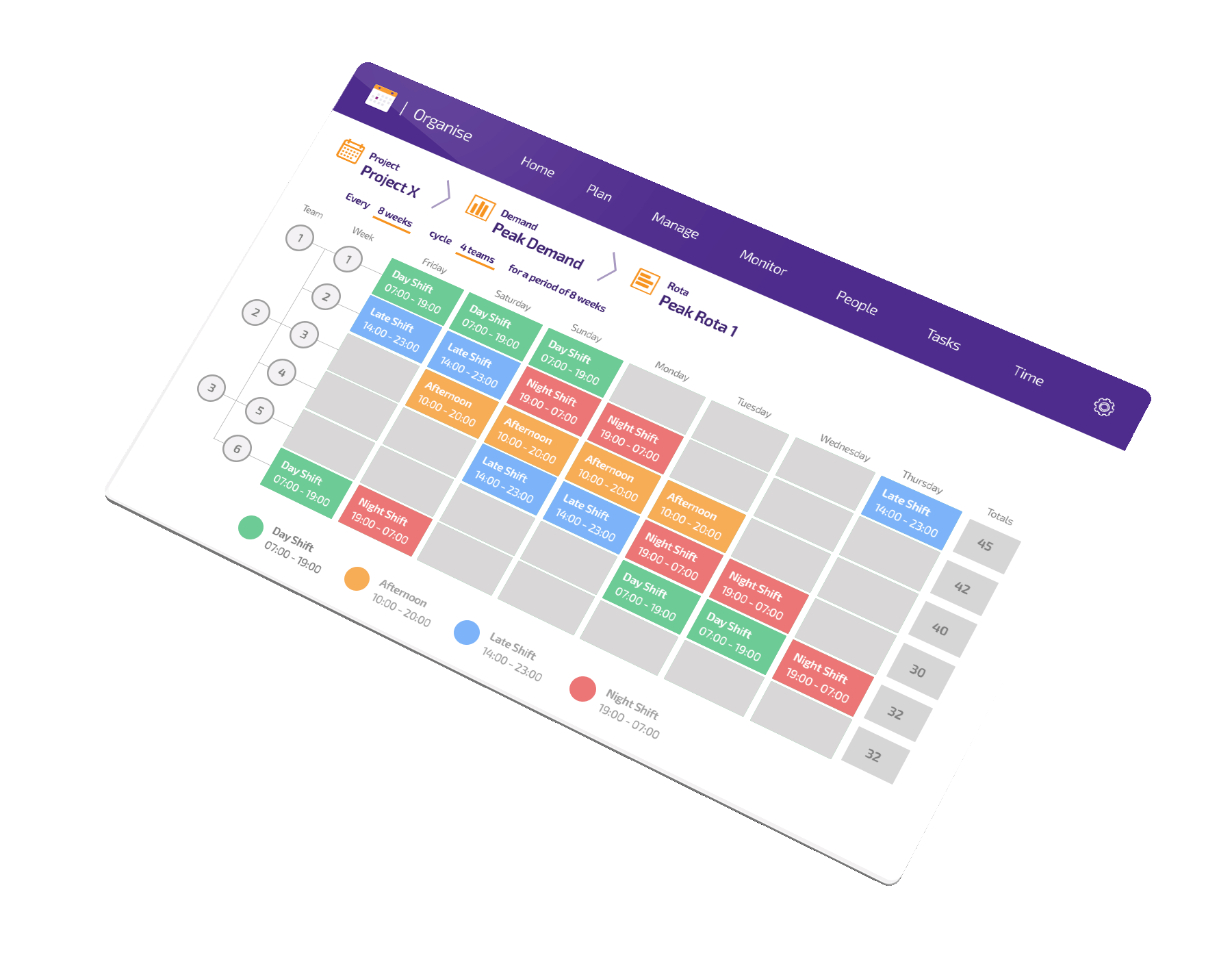An Employer’s Guide to Introducing Annualised Hours
This blog briefly looks at how employers can introduce annualised hours to benefit employees and the organisation.
Annualised hours contracts are well suited to organisations with field service operations looking to improve productivity, reduce overtime and improve recruitment and retention. Introducing annualised hours requires a planned, considered approach to ensure it meets the needs of all stakeholders now and in the future.
Top five reasons to implement annualised hours
Our shift work and rostering experts find that organisations with field service workers typically implement annualised hours to:

1. Reduce unnecessary costs
Annualised hours help eliminate waste by better matching working hours to fluctuating demand. Creating shift patterns that fit anticipated variations in demand over any given period reduces the unnecessary use of overtime and/or agency workers. By lowering costs through annualised hours, more can be invested in base salaries to provide mobile workers with a more predictable income and help with recruitment. Annualised hours can deliver a 15% reduction in labour costs by reducing overtime and agency use.
2. Improve productivity
When mobile workers’ shift patterns don’t align with demand, there is typically underutilisation during quieter times and capacity gaps during busy periods, which leads to productivity-eroding overworking. Annualised hours ensure employees’ contracted hours from ‘quieter’ periods of the year/week/day can be re-deployed to support when there is peak demand. This dynamic demand planning means annualised hours can deliver 55%+ improvement in productivity for organisations with field service operations.
3. Support recruitment and retention
Annualised hours help address many issues behind mobile worker dissatisfaction, including long working hours, uncertainty, lack of flexibility and negative work-life balance. Annualised hours can give employees more predictable working hours and adequate notice of shift changes so they can plan their personal lives better. Effective use of annualised hours also creates more opportunities to design shift patterns suited to demographics such as working parents, students and those looking to work reduced hours during specific periods of the year. There is a considerable number of options available within annualised hours. For example, annualised hours contracts can span diverse hours (part-time hours, full-time hours, options in between), seasonal arrangements and different shift lengths.
4. Increase flexibility
Organisations with field service operations need to respond to a wide range of factors that influence demand and mobile worker preferences. Annualised hours provide more flexibility to quickly change shift patterns to align better with new operating conditions or workforce circumstances. In many organisations, annualised hours underpin resilience, competitiveness and success.
5. Reduce complexity
Field service operations with legacy contractual T&Cs often have a complex ‘patchwork quilt’ of working arrangements, pay rates and holiday allowances. Annualised hours contracts standardise this and remove payroll and shift pattern anomalies. Administering annualised hours is often much more straightforward and increases fairness, boosting mobile worker satisfaction.
How do you implement annualised hours?
Unsurprisingly, we regularly are asked how you implement annualised hours in a field service environment. Adopting annualised hours centres on five fundamental elements:
1. Forecast: Annualised hours require you to undertake business analysis. You’ll need to create a baseline by quantifying the ‘target’ number of total workforce hours required for the year to meet demand in your field service operations.
2. Profile: These total hours need to be broken down and assigned to reflect flat or fluctuating demand profiles over a year (this can be targeted towards in-day variations). This is the key to annualised hours ensuring mobile workers’ contracted hours are deployed in shift patterns that fit anticipated demand.
3. Supply: The ‘target’ number of hours can be divided by the optimal annual hours contract size to arrive at the theoretical number of mobile workers and team structures required to meet the forecasted demand in your field service operations.
4. Design: Using these forecast, profile and supply calculations, a set of operating principles can be designed which apply to a range of areas such as shift patterns, annualised hours contracts, reserve hour rules and holiday procedures. Your annualised hours system can then be tailored to the specific needs of your field service operations, its predicted demand profile, legislative requirements and workforce demographics.
5. Engagement: Mobile workers should be meaningfully involved in planning, designing, implementing and maintaining annualised hours. They are the ones who will be working the shift patterns and are crucial to the success of your field service operations.
What is annualised hours law?
Annualised hours must be implemented and managed in a way which complies with an employer’s legal obligations. Because annualised hours calculate mobile workers’ working time and pay over a standard year, rather than by the week, additional consideration must be given to employment laws such as Working Time Regulations and Holiday Pay.
Other things to consider concerning annualised hours law include:

Compliance with National Minimum Wage
Standard annualised hours contracts (where employees are paid a set weekly salary for a set number of hours over the course of the year, but the hours worked from week to week vary) count as ‘salaried work’ for the National Minimum Wage legislation. To ensure their contracts are legal, employers must pay the National Minimum Wage for the average weekly hours worked. This legality is the case even if mobile workers receive less than the National Minimum Wage for hours worked in a particular week.
Indirect Discrimination
Many annualised hours contracts incorporate an element of flexibility. This includes prescribed periods when mobile workers know they may be required to increase their hours. To avoid the risk of indirect discrimination, employers introducing these contracts need to ensure that the business aims are balanced with any detrimental impact on a particular group of employees. This includes those with childcare commitments and must consider whether there are alternative ways to achieve those aims which reduce any such detrimental impact. As every organisation and annualised hours contract is different, it’s vital that you seek legal advice when planning an annualised hours system for your field service operations.
Co-design annualised hours with employees
Involving mobile workers in designing shift patterns for an annualised hours system is key to improving outcomes. Totalmobile’s Organise software has a shift pattern design tool that helps employees visualise the impact of annualised hours shift changes and allows them to experiment with variants.
Our shift work and rostering experts can help you structure a collaborative process that unlocks valuable insights and helps create an annualised hours system that balances your organisation’s and its employees’ needs.
Contact us to speak to an annualised-hour expert or to demo Totalmobile’s Organise software.








